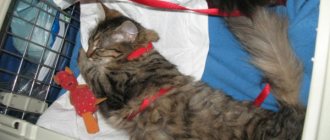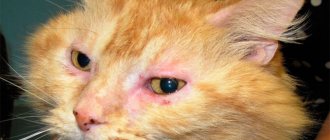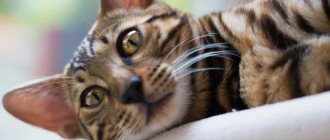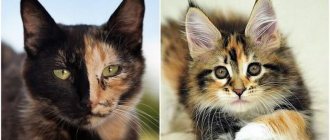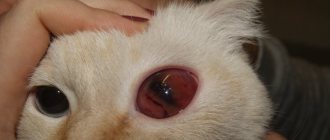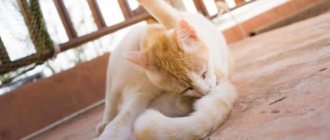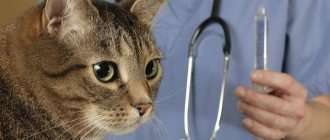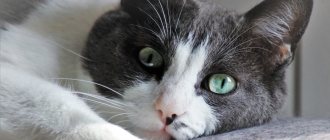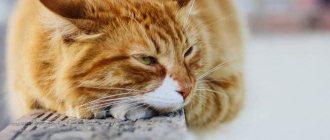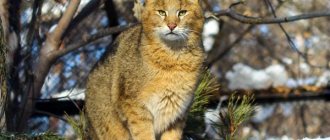A hernia in domestic animals is a pathological process that is accompanied by displacement of the abdominal organs with their protrusion into the subcutaneous layers or into the peritoneum. Most often, displacement of the uterus, intestinal loops, and organs of the urinary system occurs.
There are umbilical, inguinal and perineal types of the disease, as well as congenital and acquired. A hernia is the most common surgical pathology in domestic cats, in which organs protrude through the umbilical opening.
Causes of umbilical hernia
In its structure, the pathology is a small opening (canal, gate), the part of the abdominal wall emerging from it forms a hernial sac. The movement of nearby organs occurs into it: the uterus or its parts, the bladder, the peritoneal omentum, and intestinal loops. Organs displaced from their anatomical places form hernial contents.
The umbilical type of the disease is most often observed in small kittens due to abnormalities in intrauterine development. In adult animals, hernias are acquired.
Veterinary experts believe that the following factors lead to the appearance of pathology in pets:
- Genetic predisposition is one of the main reasons for the formation of an umbilical hernia. The genes are responsible for the formation of the umbilical ring during fetal development. Malfunctions in the gene apparatus lead to an abnormal structure of the ligamentous apparatus and the umbilical vein, which provokes the formation of the umbilical opening.
- Some breeders believe that the cause of the pathology is the owner's incorrect actions when the umbilical cord breaks , which leads to the expansion of the umbilical ring. The inexperience of a young mother cat that incorrectly gnaws the umbilical cord of newborns can also lead to trouble.
- Increased intra-abdominal pressure is a common cause of development. In both small kittens and adult animals, blood pressure increases with severe constipation, vomiting, and excessive physical activity.
- Various injuries and mechanical damage are the cause of acquired pathology. Falls from heights, blows, and bruises lead to stretching of the abdominal muscles and displacement of internal organs.
We recommend reading about what to do if your cat develops a tumor. You will learn about the reasons for opening a tumor, the rules for treating a wound, and treating a tumor. And here is more about the reasons why a cat doesn’t eat.
Perineal hernia
A perineal hernia is a unilateral or bilateral protrusion under the anus in cats and under the genital opening in cats. The formation is soft to the touch and painless. If you lift a cat by the front limbs, the hernia will increase in size, and if you lift the animal by the hind limbs, you can see how the hernia disappears.
Treatment
As a rule, strangulation of perineal hernias does not occur, therefore, with small sizes, the hernia is observed without using any therapeutic measures. For large and medium-sized hernias, hernia repair is performed under anesthesia.
The appearance of hernias is promoted by frequent constipation in a cat, urination disorders, frequent childbirth, trauma, surgical interventions, as well as genetic predisposition. Based on this information, to prevent hernias, it is necessary to treat and prevent diseases of the gastrointestinal tract and genitourinary system, protect the animal from injury, provide proper care and regular examinations both at home and at the veterinarian.
Is this an umbilical hernia?
If you suspect an umbilical hernia in your beloved pet, the owner should know that there are also inguinal and perineal pathologies. The groin type of the disease is observed in females. It is a soft, dough-like protrusion in the abdominal area. The development of this type of hernia is provoked by chronic constipation and flatulence in animals.
Inguinal hernia
In females, the contents of the hernial sac often contain fragments of the uterus and even embryos, which provokes reproductive dysfunction and leads to infertility. The causes of surgical disease are also anomalies in the development of internal organs and trauma.
Perineal hernia is diagnosed less frequently in domestic cats; older animals are predominantly affected. The main cause of the disease is degenerative changes in the pelvic muscles. In this case, fragments of the intestine, urinary tract, and prostate gland enter the hernia cavity. This type of hernia is more often observed in castrated cats. A characteristic feature of the pathology is that when the cat is lifted by the paws, the protrusion changes its position.
Pericardial-peritoneal hernias
They are also practically never encountered in practice. These hernias are derived from diaphragmatic hernias. Most likely, their low prevalence is explained by the sad fact that a tiny number of animals survive to fully develop the pathology. The fact is that with this disease, intestinal loops put pressure directly on the pericardium (the outer lining of the heart). This causes the development of chronic heart failure, pulmonary edema is common, and hydrothorax is possible. Therapy is the same as in the case of diaphragmatic hernias, but here special attention should be paid to maintaining the cardiac and respiratory activity of the animal’s body.
How dangerous is an umbilical hernia for a cat?
In itself, displacement and protrusion of internal organs is not a life-threatening condition for the animal. However, even non-strangulated hernias provoke disruption of the normal functioning of internal organs.
However, all hernia pathologies without exception are fraught with strangulation. This phenomenon occurs when it is impossible to reduce the contents of the hernial sac.
a) Palpation of the hernial contents with the cat in the supine position; b) Digital reduction of the umbilical hernia.
Irreversible pathology leads to impaired blood supply to strangulated organs and tissue necrosis. Rapid inflammation of the surrounding tissues occurs, and the animal experiences severe pain.
When vital organs (bladder, intestines, uterus) are infringed due to necrosis, general intoxication of the body occurs. Necrotic phenomena in advanced cases cause the death of a pet from developing sepsis. The death of an animal can occur due to severe painful shock.
If the protrusion in the navel or abdomen cannot be reduced, is hard, painful, there is fever, vomiting and refusal to feed, the pet should be immediately taken to a veterinary facility.
Hernia in a cat after sterilization: what is it?
Without going into details, a hernia is a pathological phenomenon, the meaning of which is that part of the internal organs gets under the skin. Those. a kind of “bag” forms on the cat’s stomach, inside of which (in most cases) there are intestinal loops, sometimes there is also a piece of the liver or other internal organs. They get under the skin through the hernial ring.
Roughly speaking, this is a hole in the muscle membrane. A hernia, even a small one, should never be taken too lightly:
- Such neoplasms always show a pronounced tendency to increase in size. In advanced cases, a hernia may grow on the cat’s stomach, the size of which can compete with a large orange.
- The insides located in the dangling hernial sac are in great danger. A cat can hit itself at any time, and the consequence of the blow is often a rupture of the intestinal loops located in the hernia itself.
- The hernial ring often has an unpleasant habit of shrinking. The result is compression of the internal organs passing through it. This leads to necrosis, deterioration of local blood circulation and other unpleasant consequences.
Treatment of umbilical hernia in a cat
Under no circumstances should you treat a sick pet yourself. It is strictly forbidden to use thermal procedures or engage in self-reduction of protruding organs. Such manipulations can lead to the development of strangulation and necrotic processes.
Treatment for protrusion of internal organs in the navel area depends on the type of pathology. In the case when the kitten is less than 6 weeks old, or the hernia is reducible, conservative methods are used. Strangulated pathologies require surgical intervention.
Conservative methods
Large hernia
Only a veterinary specialist can resolve the issue of treating the disease without a scalpel. For conservative therapy, special irritating ointments, therapeutic massage of the hernial ring, and application of a fixing adhesive plaster after reduction of the protrusion are used.
Small hernias in young animals, with proper treatment, can close by 4 to 6 months of age. Unfortunately, conservative methods are rarely effective, and the owner should decide on surgical intervention.
Surgery for a large hernia in a cat and aftercare
Herniotomy is surgical excision of the hernial sac; it is a radical and most effective way to treat hernia in domestic cats. The operation is performed both under general anesthesia and under local anesthesia using infiltration circular anesthesia. The decision on the method of pain relief is made by the attending physician.
The operation to excise an umbilical hernia is a routine surgical procedure in a veterinary clinic and rarely causes complications. During a herniotomy, the skin is incised above the umbilical ring.
For small hernias, a straight incision is made; for large protrusions, a spindle-shaped incision is made. After peeling off the peritoneal tissue, the surgeon places the internal organs into the abdominal cavity.
Using a scalpel, the lumen of the umbilical ring is reduced, and sutures are applied.
Surgical removal of the protrusion is carried out in males no earlier than 1 - 5 months, in cats - at the age of 6 months. If there is a threat of necrosis of vital organs, the operation can be performed earlier.
In the case where the hernial contents are strangulated, the surgeon excises the damaged necrotic tissue.
After surgery, the animal should be provided with proper postoperative care. First of all, the pet should be protected from vigorous physical activity and jumping from heights. The diet during the rehabilitation period should be aimed at preventing constipation and flatulence.
The seam is treated in accordance with the recommendations of a veterinary specialist. In the postoperative period, it is advisable to put a blanket on the animal to reduce the risk of infection of the sutures and prevent scratching and gnawing. Sutures are usually removed on days 10–12.
About the symptoms, diagnosis and treatment of an umbilical hernia in a kitten, watch this video:
Hernia treatment
Most experts agree that the preferred method of treating hernias is surgery. The operation is quite simple, and the stitches can be removed after 8-12 days. This approach to treatment is the most effective and also guarantees a speedy return of the pet to a normal lifestyle.
After surgery, the pet must be dressed in a blanket to protect the stitches from infection and licking by the cat. Sutures should be treated with an antiseptic solution several times a day. If you notice inflammation or discharge in the suture area, you should immediately contact your veterinarian. It is important to prevent new complications from arising.
However, if the hernia is small and harmless to the animal, the specialist may prescribe an alternative treatment method. The doctor adjusts the formation and applies a special fixing bandage (blanket). Depending on the size of the hernia and the individual characteristics of the cat, it must be worn from one to several months. If everything goes well, the formation is overgrown. This method of treatment is not very convenient, because cats are active animals, and it will be necessary to constantly check the quality of fixation of the bandage and, if necessary, correct it.
© shutterstock
If you are dealing with a diaphragmatic or intervertebral hernia, the approach to treatment is somewhat different. The rehabilitation period is much longer, and the animal requires special care . This is due to the fact that operations of this kind are more complex and invasive than in the case of other types of hernias. The most important thing is to provide the animal with rest and proper care. This is especially important in the first few days after surgery, when the animal is most vulnerable and weakened.
The outcome of the animal's life if left untreated
The risk of complications of surgical pathology due to strangulation of hernial contents in domestic cats is very high. In this case, there is a disruption in the blood supply and nutrition of the displaced internal organs. If the intestinal loops are damaged, the cat quickly develops tissue necrosis, intestinal patency is disrupted, and intoxication develops.
If the bladder or urinary tract is pinched, this condition quickly causes severe poisoning of the body with waste products, and is also fraught with rupture of the bladder. Incarceration of the uterus in a cat is also accompanied by symptoms of intoxication and is life-threatening for the pet.
In the event that the contents of the hernial cavity are infringed, minutes and hours count. There is a high probability of the animal dying primarily from painful shock. No less dangerous are the processes of necrosis, severe intoxication of the body, and the development of sepsis. In this regard, the animal, at the slightest sign of strangulated hernia, must be urgently taken to a specialized institution.
We recommend reading about intestinal problems in cats. You will learn about the causes of constipation in cats, signs, treatment and preventive measures. And here is more information about how to give an enema to a cat.
Diaphragmatic hernia
The pathology, considered one of the most dangerous and complex in veterinary medicine, can be congenital, but most often it is acquired, formed as a result of mechanical trauma. Under the pressure of a hernia, the abdominal organs exert extreme pressure on the lungs, heart and diaphragm area until it ruptures.
A diaphragmatic hernia in a cat is practically impossible to diagnose; even an ultrasound shows cloudy areas of darkening. An accurate diagnosis can be made using a chest x-ray, but before this the animal must be given barium pulp.
Clinical symptoms in kittens are not pronounced. The cat refuses to eat, becomes inactive, lethargic, breathing is intermittent, rapid, with attacks of shortness of breath, the pulse is thready. In some cases, due to severe compression of the chest vessels, pulmonary edema develops.
Treatment is surgical.
Inguinal hernia
An inguinal hernia (Herniae inguinalis) occurs in cats that suffer from constipation and flatulence; in cats, an inguinal hernia is more often a birth defect. For the most part, this pathology in cats is not dangerous. Due to the fact that the hernial sac in most cases is filled with omentum. However, things don't always work out so well. In some animals, abdominal organs begin to protrude through the inguinal canal, and in pregnant cats, a pregnant uterus may become trapped in the inguinal hernia. Cats with an inguinal hernia have the potential to remain infertile.
Symptoms. During the clinical examination, the veterinarian palpates a soft, painless swelling between the last nipple and the anterior edge of the pubic bones. With a wide inguinal ring, this swelling may disappear after pressing on it. When strangulated, the inguinal hernia becomes denser and more painful on palpation. Externally, the cat often lies down and licks the surface of the hernia. All other signs of this complication appear more strongly in a cat when a loop of intestine or bladder is pinched.
The diagnosis of an inguinal hernia is made by a veterinarian based on the symptoms of the disease.
Treatment. To perform the operation, the cat is fixed in a dorsal position. The operation is performed under combined anesthesia. The veterinarian makes an incision in the skin and subcutaneous tissue along the greater curvature of the swelling, 5-6 cm long, and then dissects the hernial sac to the hernial ring. Expansion of the hernial ring, if necessary, is done only in the anterolateral area. In its caudal area, it is necessary to avoid injury to the external pudendal arteries and veins. The hernial sac is twisted along the longitudinal axis, bandaged as high as possible and the ligature cut off below. Knotty sutures made of biocompatible polymer threads “Kapromed” are applied to the edges of the hernial ring. The wound cavity is sutured and the operation is completed by applying a knotted silk suture to the skin.
Diagnostic procedures
In addition to palpation, pathology in an animal can be detected using ultrasound.
Only a veterinarian can distinguish an umbilical hernia in a kitten from other pathological disorders. If unpleasant symptoms appear, you should contact a veterinary clinic. Often, to make a final diagnosis, it is enough for a specialist to conduct a visual examination of the pet and palpate the abdomen. To assess the condition of internal organs and the severity of the disorder, additional laboratory and instrumental diagnostic methods can be performed. The basis for diagnosing an umbilical hernia in a kitten is ultrasound examination.
Hernia prevention
Preventive measures will help to avoid hernial sacs on the cat’s body, and, accordingly, surgical intervention in the body will not be necessary. Of course, this does not apply to congenital pathology in a kitten.
- The animal must have a properly selected diet that eliminates problems with digestion and bowel movements.
- Frequent childbirth provokes hernia formations, so it is necessary to limit the number of matings in the female.
- An open balcony and window are a risk of injury to the purr.
- If abdominal surgery has been performed, the animal must be provided with comfort and care. You will also need to limit the cat's activity until complete recovery. Take care of your beloved cats!
Sources:
https://yunacenter.ru/gryzha-u-koshki-kak-diagnostirovat-i-lechit/
https://101kote.ru/stati/gryzha-u-koshek.html#Profilaktika-gryzhi
https://murkote.com/grizha-u-koshek/
